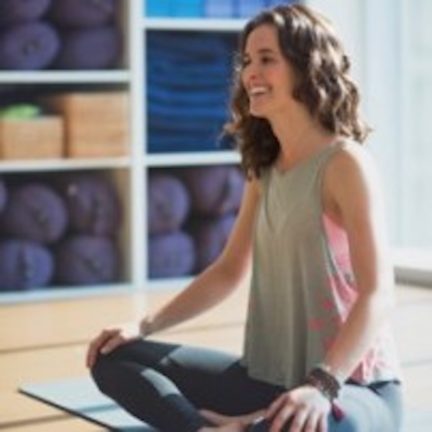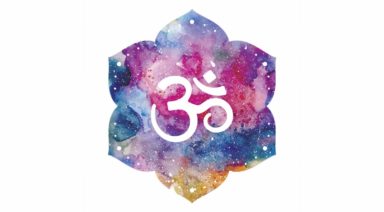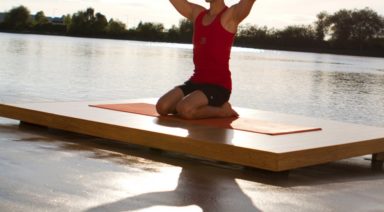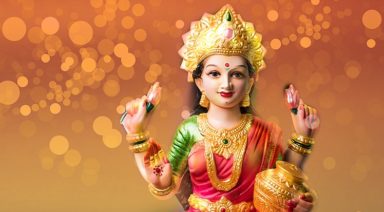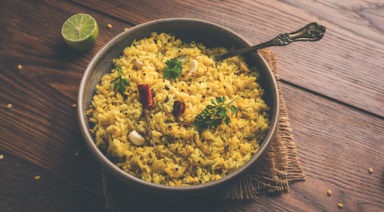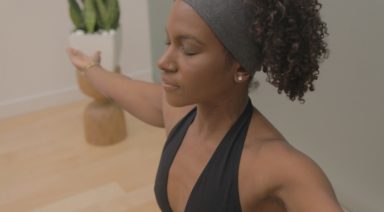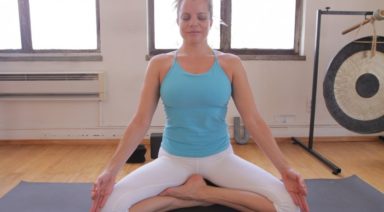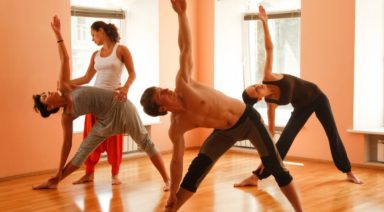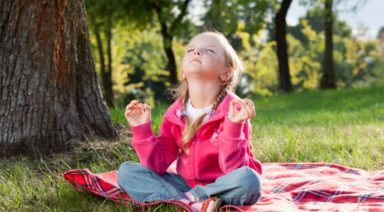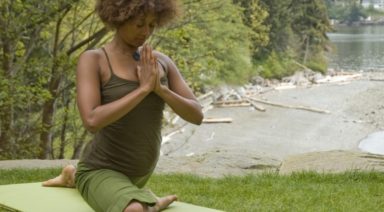Yoga Mala
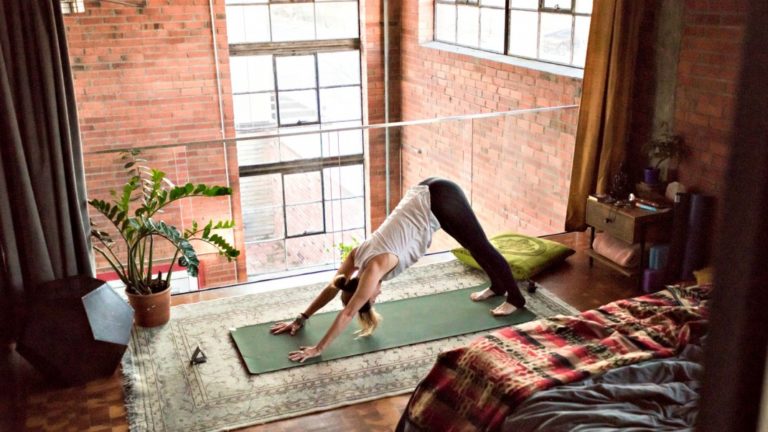
A mala, meaning garland in Sanskrit, evokes a circular, continuous form. In practice, a mala is the devoted offering of repeated cycles (typically in divisors of 108) of mantra Japa or yoga asana. Within a mala, there is always a sense of beginning, continuing, and completion. Both inside each individual cycle and in the practice as a whole. This three-form (trimurti) quality allows us to embody, in practice, the rhythmic cycles ever-present in the natural universe: creation (srishti), sustaining (sthiti) and destruction (samhara).
During a yoga mala, the types of offerings include mantra japa, pranam and yoga.
Offering: Mantra Japa
Chanting mantra, either internally or aloud, has a vibrational impact on the body and mind. A mantra, meaning a tool or skill of thought, imbues the practice of yoga with a primordial rhythm and when offered continuously (japa), mantras are designed to liberate consciousness.
“Mantras are the sounds that should accompany our yoga postures. Like strands of DNA, these sounds offer yoga practitioners a direct link to the source and substance of the yoga tradition. Just as you cannot truly grasp science without knowing its language—mathematics— it is impossible to touch upon the depth of yoga without knowledge of mantras.” ::Russill Paul, The Yoga of Sound
When preparing to practice mantra Japa, select a mantra that resonates with what you want to cultivate through your offering. Included below are several mantras that serve different purposes in practice. They are short, potent and readily learned through repetition. While an English mantra may be just as powerful, the Sanksrit mantras are intelligently crafted to awaken your whole being with vibration, not just the mind.
| MANTRA | MEANING | INTENTION |
|---|---|---|
| oṁ namaḥ shivāya | I bow to the inner Self who is one with the source of all creation | union |
| oṁ hrim hamsa soham svaha | I bow to the supreme light, to emerge from darkness | purification |
| oṁ maṇi padme hūṃ | May the jewel in the lotus shine forth the light and love of compassion to unite all as one. | compassion |
| oṃ guṃ gaṇapataye namaha | I bow to Ganapati the benevolent remover of obstacles. | overcoming obstacles |
| lokāh samastāh sukhino bhavantu | May all beings everywhere be happy and free. | metta, lovingkindness |
Offering: Pranam
For a gentle, yet transformative practice, you may choose to offer pranams (prostrations) in lieu of the traditional namaskaras (salutations) outlined below. The practice of prostration or kneeling is common to many spiritual traditions and the physical gesture of bowing is understood universally as conveying respect, honor, and reverence.
A pranam is the simple surrender of the whole body to the earth in a prone position.
Begin standing, then lower the hands to the ground and slowly walk them away from the feet to place the belly on the floor. Rest the forehead on the hands like a pillow and stay here for at least one cycle of breath. To complete the pranam, in your own way, press the body up off the floor and return to standing. Use the breath to initiate each movement and move slowly. With relatively uncomplicated form, a mala of pranams may be completed with the eyes closed to facilitate deeper focus and meditation.
Offering: Yoga
A yoga mala can be completed using any combination of practices that totals 108, or for a shortened practice, 27, 54, etc. My favorite way to practice a yoga mala is by completing 12 total cycles, each consisting of 7 surya namaskar A and 2 surya namaskar B, 12 x 9 = 108. Typically, postures for traditional sequences.
Modifications
In this style of yoga mala, there are potentially more than 200 forward bends and more than 150 “push-ups”; For even the most seasoned yoga practitioner, this is a lot to ask of the body. Listed below are common modifications to the traditional form to encourage a sustainable practice that leaves you feeling nourished, not depleted. You may decide to modify every round or alternate between full and modified expressions as is appropriate.
Upper Body
- Bend the elbows for any postures where the arms are extended overhead. This is a great option for anyone with shoulder sensitivity or as the arms begin to fatigue. This can also alleviate dizziness and is recommended for anyone with hypertension
- Skip the basic vinyasa (chaturanga and upward facing dog) and step straight back to downward facing dog from forward bending. Enjoy a few extra moments to catch your breath in downward dog or rest in child’s pose instead
- Substitute cobra or locust pose for upward dog. These postures extend the spine in the same way with little to no weight bearing on the hands
- Substitute forearm plank and dolphin for plank and downward dog for sensitive wrists. When taking this modification, it is recommended to transition slowly from hands to forearms with the knees lowered
- Substitute puppy pose or child’s pose for downward dog, placing less weight on the hands
Lower Body
- Bend the knees in forward bends. This is recommended for all practitioners, even those with an advanced forward bending practice who can very easily touch the ground with straight legs. A gentle bend in the knees will help recruit the larger muscles of the legs for support, especially when the body becomes fatigued, instead of defaulting to the knees and lower back. Similarly, maintain a gentle bend in the knees as you transition from forward bending to standing
- Substitute high or low lunge for warrior one. Lowering the back heel in this split-leg posture requires significant mobility in the hips and legs, enjoy these lunge modifications for several rounds in the beginning until the body is sufficiently warm or as alternatives to warrior one when the legs become tired
Transitions
- With a fluid and repetitive rhythm, it can be easy to hurry from one pose to the next. A mala can be practiced with one breath per movement, but enjoy additional breaths as needed and do not rush through the process. It is far better to complete 54 rounds safely and with self-compassion than to suffer through 108 for the sake of the numerical metric
Your Practice is Personal
The practice of a yoga mala can be deeply cleansing and invigorating, especially when completed during a seasonal shift such as a solstice or equinox. This practice is also welcomed during any time of personal transition or universal celebration. The new year, for instance, is a potent time of creation as we chart a path for the year to come. Through the dedication of a yoga mala, we can dissolve what has passed and galvanize our intentions for the year ahead.
A Moving Meditation
A yoga mala is the ultimate moving meditation with a repetitive, steady rhythm that helps transcend the purely physical form and move us closer to the unified Self. One body, one mind, one breath. Each forward bend serves as a pranam to the source and each vibrant backbend is an emergence of radiant light. The body is the mala, the breath is the mantra.
My dear friend and yoga teacher once told me that praying is when you ask the big questions whereas meditation is when you listen for the big answers. A yoga mala offers us practice for sweating our prayers in movement so that we might listen for what arises in meditation.
What is the Significance of 108?
The number 108 has a range of significance across many different cultures and disciplines. For example, this number informs the architecture of sacred texts that are central to yoga and eastern philosophy. As a devoted scholar of yoga and tantra, my teacher Shiva Rea explains in Tending the Heart Fire, “there are 108 chapters of the Rig Veda, 108 Upanishads, and 108 primary Tantras.” And these texts are written in Sanskrit, a language comprising 54 letters, each with a masculine (Shiva) and feminine (Shakti) form, 54 x 2 = 108. Additionally, listed below are just a few of the many relationships that carry this number.
- In in the field of Ayurveda, there are 108 sacred places, or marmas, in the body, identifying intersections of matter and consciousness. When manipulated, these points can awaken and align the vital energy
- Members of the Vedic tradition see this number as denoting the wholeness of the universe: one represents the solar masculine, zero represents the lunar feminine and eight represents the infinite nature of all things
- In the classic japa mala, used in Buddhism and Hinduism, there are 108 beads used for prayer and mantra
- Mathematicians favor the number 108 for its countless patterns and potential divisions. For example, it is divisible by the sum of its parts and most of its proper divisors, making it a semiperfect number
- Through the lens of astronomy, the diameter of the sun is approximately 108 times that of earth and the distance from our planet to its solar star is, on average, 108 times the diameter of the sun. A similar parallel relationship also exists between the earth and the moon
The unequivocal nature of numbers, unlike language, is absolute. However, it is the way in which we relate to and extract meaning from numbers that brings them to life. Be it randomized coincidence or divine order, there is something undeniably special about one hundred and eight.
How to Keep Count
A mala uses repetition to break free from the fluctuations of the mind, so it may seem counterintuitive to introduce any method of keeping count, which can be a predominantly mental exercise. When offering japa mantra, this conundrum is easily solved using of a string of beads or stones. With the completion of each cycle mantra, the beads are delicately transferred through the fingers of the right hand, beginning and ending with the large bindu, or guru bead, for a total of 108 rounds. In a yoga practice, this task compels a little more creativity, but it need not be complex. You might use small pieces of paper, beans or seeds, or even the chakras of the body to count internally.
To practice a mala with the traditional sequences outlined above, you will simply need three different styles of counters and four small containers or piles. When I offer personal practice, I use three different colored beads and four small clay cups. The first cup has seven clear beads, each representing one surya namaskar A and two wooden beads, each representing one surya namaskar B. The second and fourth cups are empty and the third cup has 12 rudraksha beads, each representing a complete round.
When completing a single round, the seven clear beads and two wooden beads are transferred from the first cup to the second cup at the end of each surya namaskar A and B respectively. When the transfer is complete, a single rudraksha bead is transferred from the third cup to the fourth cup. In the next round, seven clear and two wooden beads are returned from the second cup to the first cup, and another rudraksha bead is transferred from the third to the fourth cup. The clear and wooden beads are continuously transferred between the first and second cups until all rudraksha beads are in the fourth cup. It may seem complicated, but give it a shot, it’s easier than you think.
Remember, the completed number of mantras or asanas is not what matters most. You may choose to let go of the numbers altogether and simply practice until your heart feels complete.
10 Ways Yoga Practice Can Lessen Your Holiday Stress

There is no better time to take your yoga practice “off the mat and into your life” than over the holidays! Whether you are a new student of yoga asana (movement) or a seasoned yogi, here’s a handy guide for using all the tools at your disposal–including breath, movement, and mindfulness–to limit stress and maximize happiness in the coming months:
1. Stay healthy.
Chronic health issues often flare up over the holidays, so don’t forget to use your yoga practice as preventive medicine. Keep persistent symptoms at bay with a daily dose of yoga. Drain your lymphatic system and increase blood circulation through postures and movement.
Try combating infections and colds by opening up your chest with a gentle fish, bridge, or bow pose. Don’t skimp on your yoga just because you are busy! Everyone has time for a quick round of sun salutations in the morning, a few standing forward bends at lunch, or some breathing techniques before bed–no mat or props needed. Remember the old saying: An ounce of prevention is worth a pound of cure. Were they talking about yoga?
2. Be worry-free
“I’m so stressed out. My mind is racing. Everything seems overwhelming. I just can’t stop thinking!” Are anxious feelings wearing down your holiday spirit? Politely excuse yourself from the party; turn off the computer – just take a break. Find a quiet, peaceful spot for some yogic mantra or meditation. You can quickly detach from worrisome thoughts by focusing on the individual sounds of the mantra or by simply following the breath – in and out.
Sometimes a longer exhalation or pausing at the end of your out-breath can calm a speedy mind. If time permits, do some asanas – child’s pose to really let go, balancing poses (like tree pose) to connect to earth and sky, or toe squat to stretch your feet and take the focus out of your mind and into your body. A restorative yoga session can be an hour well spent; your worries will literally melt into the mat and leave you feeling clear and refreshed.
3. Increase your concentration.
As if your life isn’t hectic enough, add in holidays with extended family, shopping, school recitals, the annual office party; the list goes on! All these distractions can wreak havoc on our memory, concentration, and problem-solving. In order to stay productive, incorporate asanas that increase mental focus–like warrior I, II, III, dancer’s pose, eagle pose, or shoulder stand–into your practice. Activate your tired brain with a series of breathing exercises. You can do them anywhere, anytime, seated or standing.
Really crunched for time? Take a few moments sitting in a comfortable seat (eyes closed or with an unfocused gaze), or stand in mountain pose with your hands in anjali mudra (palms together in front of your chest). The simple act of remaining still with palms pressed together can help bring you back to your center.
4. Keep your body toned and fit.
Maybe you’ve done one yoga class, maybe one thousand. No matter your strength, flexibility, muscle tone, core stabilization, balance, cardio health, enhanced athletic performance–the benefits of yoga become apparent with that very first stretch or twist. You might have a consistent practice when November rolls around. Suddenly there’s no time to cook dinner, let alone squeeze in an entire yoga series.
What to do? Do something rather than nothing! Try adding a few minutes of yoga before or after a workout, run or walk. Strike a few powerful poses before the kids get up in the morning, or discretely activate your core with tummy toning exercises while sitting on the couch. During the holiday season, concentrate on the target areas most important to you, and the rest can wait. If you need shoulders flexibility, keep up your downward dogs; if your spine is an issue, don’t skimp on back-bends, forward bends, and twists; if tricep strength is what you’re after, practice chaturangas as often as you can during your yoga flow.
5. Keep your weight stable
Everyone knows a good yoga series burns calories, builds muscle, and provides your body with a systematic, holistic workout. More importantly, yoga practice helps you make friends with your body. This is no small statement. When you know your body, you eat more consciously, recognizing the difference between a food craving and actual hunger. You make more sensible food choices, and intuitively eat less because you know when you are actually full.
Over the holidays, even our most thoughtful meal planning can be disrupted, it’s hard to say no to grandma’s pumpkin pie, or your cousin might be eyeing your dinner plate to see if you’ve eaten all his homemade mashed potatoes. Try keeping your “yogi mind” at family dinners. Stay centered, drink plenty of water, and don’t forget to breathe deeply when you feel stressed or overwhelmed. You can also practice cardio yoga styles during the holidays– power vinyasa, warm or hot flow, sculpt with weights–to get maximum aerobic benefits in the shortest amount of time.
6. Lift your mood and maintain a positive outlook.
Yoga practice is a great way to boost sagging spirits and tame your depression. Yoga raises your heart rate and gets the blood flowing throughout the body.
If you are feeling blue, try stretching your arms overhead and spreading your toes wide in a simple raised arm mountain pose. Backbend in bridge or cobra, opening your chest, rib-cage, and heart. Any inversion that gets your head lower than your heart–supported headstand, legs-up-the-wall pose, shoulder stand, or handstand–can have a positive effect on mood. If the holidays have really got you down, remember to take care of yourself.
Relax and rejuvenate in your favorite restorative pose; don’t skimp on any blankets or props needed for extra comfort. For mental stimulation, use a breathing exercise like bellow’s breath to stir your prana – it’s better than a cup of coffee! Let your yoga practice serve as a physical reminder that your mood won’t stay low forever. Change happens all by itself if you stay on your mat, breath, and follow the sequence of poses.
7. Sleep more
Work is stressful and your parents are coming for an extended holiday stay. You’re worried and anxious so it’s hard to fall asleep. You toss and turn all night, and now you’re cranky and irritated at breakfast. The sleep deprivation cycle begins and with it all the troubling symptoms; insomnia, exhaustion, overstimulated nervous system, chronic stress, sensory overload, muscle tightening, tension headaches, and more.
How can yoga help? Get in a rigorous session during the day, so your body is tired by nightfall, or try a gentle yoga series before bed. Deep exhalations allow your nervous system to relax and your breathing to slow down. Use poses that relieve physical tension such as spinal twists (seated or supine), plow, or a gentle forward fold (let your head hang). Turn out the lights, turn off the day. Climb into bed and let it all go with a final savasana.
8. Improve your vitality and energy
What happens when you follow a sequence of yoga movements choreographed to the rhythm of your breath? Your blood flow increases, more oxygen gets delivered to your cells and tissues, red blood cell and hemoglobin counts rise. You feel rejuvenated. What about when you’re tired? A series of sun salutations can warm and stimulate both the body and the mind. Chair and eagle are also energizing poses you can do anytime; hold them longer to generate more heat and internal energy.
Be sure to make an extra effort to keep your yoga practice going over the holidays; you’ll be rewarded with more vibrancy and stamina to enjoy the whole winter season. Did you overindulge in turkey, stuffing or green bean casserole at Thanksgiving dinner? You’re not alone. Intestinal symptoms like indigestion, acid reflux, bloating and constipation can sap your energy. Wind removing pose (wide leg, legs together, or one leg at a time to target different segments of your colon), twisting poses (to massage your abdomen), reclining bound angle pose (for all your abdominal organs), or some gentle cat-cow movements can offer instant relief for intestinal distress.
9. Maintain your mind-body connection
First, you cut your thumb chopping walnuts for the holiday cookies. Then you trip in your new high heels, twisting your ankle, and minutes later you spill wine on the carpet. Why are we so clumsy and accident-prone during the holiday season? Blame it on the stress- feeling overwhelmed can make you move too fast, lose your mind-body connection, and react with a fight-or-flight response to ordinary situations.
After bandaging your thumb, soaking your ankle, and cleaning the wine stain, cut the cycle of mindlessness- come back to your yoga! Try breathing exercises, balancing poses, or seated meditation. The mindfulness coupled with the physical embodiment your yoga brings can help you recover faster, protect you from further injury, improve your coordination and reaction time, and help you balance better (especially in those heels).
10. Be centered, present, and in the moment
Your commitment to yoga practice is the most precious gift you can give to yourself. Don’t hesitate to use all of your yoga tools– breath, movement, and mindfulness– to keep your holiday season stress-free. Enjoy. Appreciate. Celebrate. Mourn. Rejoice. Connect. Forgive. Extend. Radiate. When you are centered, present, and in the moment, you can give and receive, love and be loved, touch and be touched back. Happy Holidays and Happy Yoga.

